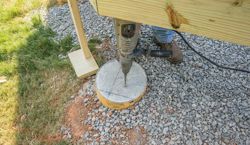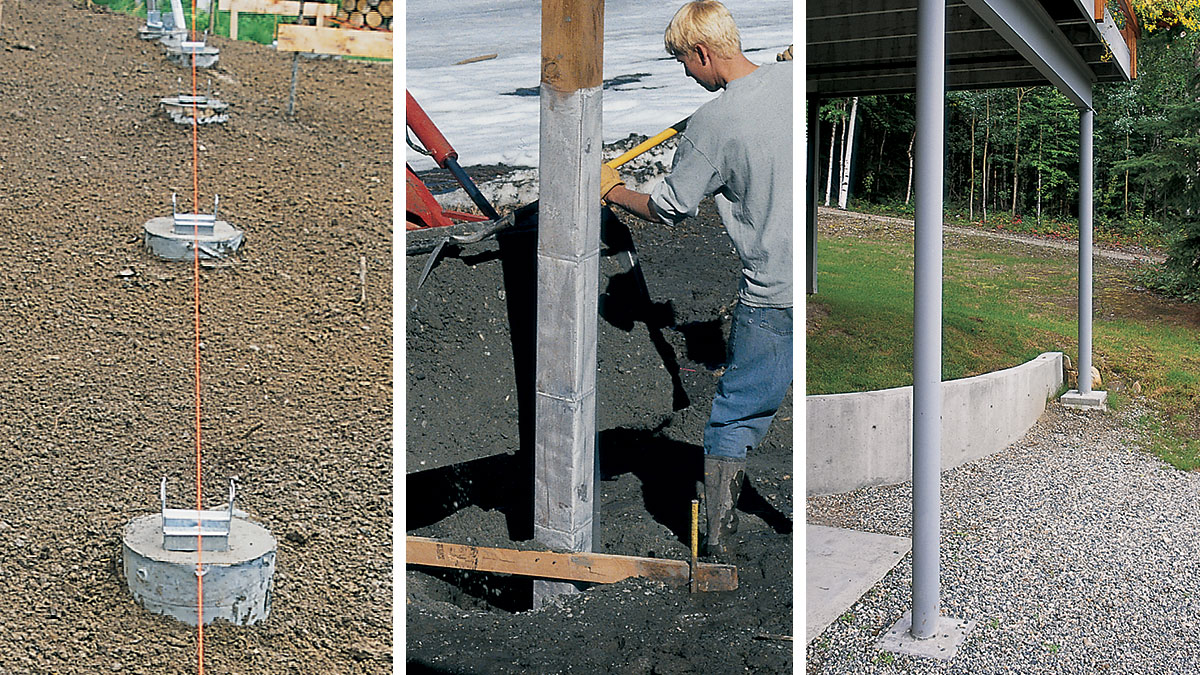Deck Footings 101: Building a Strong and Steady Exterior Sanctuary
Wiki Article
Building a Strong Structure: Introducing the Tricks of Deck Footing
When it concerns building a deck, one important facet that usually goes ignored is the foundation or footing. A properly designed and solid deck ground is necessary for the stability and long life of any kind of deck framework. In this interesting guide, labelled "Structure a Strong Foundation: Introducing the Secrets of Deck Footing," we will discover the value of proper footings, the various types available, and the variables to consider when picking the ideal ones for your deck task. Additionally, we will certainly supply step-by-step directions on how to prepare and mount grounds properly. We will discuss the relevance of normal maintenance and examination to make certain the continued safety and resilience of your deck footings. Join us as we discover the keys to constructing a reliable deck foundation.Significance of Proper Grounds

Among the key reasons correct grounds are vital is to protect against the deck from shifting or sinking. Grounds that are not deep adequate or are inadequately constructed can create the deck to work out erratically or move with time. This can cause an irregular deck surface, triggering a stumbling hazard and endangering the architectural integrity of the whole deck.

In addition, correct grounds also help to protect the deck from wetness damage. By elevating the deck framework in the air, grounds protect against the timber from entering direct call with wetness, lowering the risk of rot and decay.
Sorts Of Deck Grounds
The option of ideal deck footings is an essential aspect in making sure the security and long life of a deck structure. There are numerous kinds of deck footings that can be used, each with its own benefits and factors to consider.One common sort of deck ground is the concrete pier ground. This involves excavating holes in the ground and putting concrete to produce a solid foundation for the deck. Concrete piers are functional and can be made use of in a variety of soil conditions, making them a prominent option for numerous deck jobs.
Another choice is the helical pier ground. This kind of ground is composed of a steel shaft with helical plates that are screwed right into the ground.
For decks built on superficial or flat structures, a superficial footing may be appropriate. Shallow grounds are typically made of concrete and are placed straight on the ground surface. They are best suited for smaller decks or locations with stable dirt problems.
Factors to Consider When Selecting Footings
When choosing footings for a deck, it is vital to meticulously consider several variables that will inevitably identify the stability and longevity of the framework. The initial aspect to consider is the kind of dirt on which the deck will be built. Various soil types have varying load-bearing capabilities, so it is important to assess the soil's capability to sustain the weight of the deck. Furthermore, the environment of the area should additionally be taken right into account. Extreme weather, such as freezing temperature levels or heavy rains, can affect the ground and possibly create movement or moving of the grounds. Another crucial element is the dimension and elevation of the deck. Larger decks with numerous levels or heavy lots require more substantial grounds to offer appropriate assistance. The materials used for the grounds must be picked sensibly. Typical choices include concrete, helical heaps, and sonotubes. Each material has its disadvantages and advantages, so it is necessary to take into consideration aspects such as price, convenience of setup, additional reading and maintenance demands. Finally, talking to an expert engineer or professional can supply beneficial understandings and make certain that the selected footings meet regional structure codes and regulations. By meticulously thinking about these factors, homeowners can make informed choices when picking grounds for their deck, making certain a steady and long lasting structure. he has a good pointActions to Prepare and Set Up Footings
To prepare and mount footings for a deck, it is vital to follow a systematic method that makes sure stability and longevity. The initial step is to establish the size and variety of grounds required based upon the deck design and regional building regulations. It is important to excavate the dirt to the required deepness, guaranteeing that all-time low of the footing hinges on uninterrupted soil or compressed crushed rock. The next step involves placing a concrete form tube or ground kind in the opening, making sure it is degree and. The kind should expand above the ground level to stop water damage. After that, enhancing steel bars, or rebar, are placed inside the form to offer additional strength. The rebar needs to be properly safeguarded and spaced according to the design specs. When the form and rebar remain in area, concrete can be put right into the kind, filling it to the top. The concrete should be combined and smoothed using a shovel or a concrete vibe. The concrete demands to heal for the advisable duration prior to any added building takes place. By complying with these actions carefully, one can ensure that the grounds are properly prepared and set up, giving a solid structure for the deck structure.Upkeep and Examination of Deck Footings
To guarantee the long-term security and security of your deck, normal maintenance and detailed examinations of the deck grounds are crucial. The deck grounds serve as the foundation of your deck, supporting the weight and load of the entire structure.Routine upkeep needs to consist of aesthetic examinations of the grounds, searching for indicators of damage or damage. These can include cracks, sinking or moving of the grounds, or indicators of water damage. In addition, it is necessary to check the security of the footings by applying hop over to here pressure or conducting load examinations if required.
Along with visual examinations, it is suggested to schedule specialist assessments every few years. Specialists can evaluate the architectural honesty of the footings much more properly and offer professional advice on any type of essential repair services or substitutes.
Additionally, proper maintenance additionally entails taking safety nets to protect the footings (Deck Footings). This can consist of using waterproof layers to prevent water damages, making sure appropriate water drainage to prevent extreme dampness, and routine cleaning to remove particles and avoid buildup
Verdict
Finally, proper deck footings play a critical duty in ensuring the security and durability of a deck. By recognizing the different sorts of grounds offered and taking into consideration aspects such as soil problems and local building regulations, homeowners can make educated decisions when selecting grounds for their deck. In addition, regular upkeep and evaluation of deck footings is necessary to recognize any prospective problems and ensure the safety of the structure.In this informative guide, titled "Structure a Solid Structure: Introducing the Keys of Deck Ground," we will certainly discover the value of correct grounds, the different types offered, and the aspects to take into consideration when picking the right ones for your deck job.One common kind of deck ground is the concrete pier footing.To make certain the long-lasting security and safety and security of your deck, routine upkeep and thorough inspections of the deck grounds are important.In conclusion, proper deck grounds play a critical duty in making certain the stability and longevity of a deck. By recognizing the different types of footings readily available and thinking about factors such as dirt problems and regional structure codes, homeowners can make informed choices when choosing grounds for their deck.
Report this wiki page